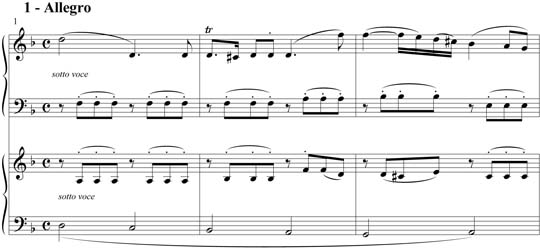transcriptions
www.pianoandco.com
I started writing transcriptions fifteen years ago with Antoine Joly – a good friend, excellent musician and amateur pianist – when he first bought a second piano. We started out with some caution, playing the early quartets of Joseph Haydn together : the 1st violin and viola parts would be assigned to one piano, the 2nd violin and cello parts to the other.
A miracle! The joy we felt was akin to that felt by those who engage in string quartet playing. The glowing sonority produced by the two pianos had no longer anything to do with the congested, muddy sound typical of the four-hand formula, with all its pitfalls in term of register and manual collision. Moreover, what we were playing were the exact notes, nothing less, nothing more than the music that had been written by the composer. There were none of the octave transpositions, none of the octave rumblings and doublings that are inevitable in four-hand playing and which produce a less than felicitous acoustical effect. In the quartets of Haydn, Mozart, Beethoven and Brahms, even the most voluble passages can be played perfectly well on the piano.
But this was only the basic principle, of course. In reality, we naturally wanted to achieve something a bit more subtle. In particular, there is no doubt that the 1st violin part of a quartet is generally more brilliant than that of the other instruments. Yet, each voice of a quartet has an equally important, though distinct, function. By redistributing meticulously the different parts from one piano to the other, we made sure that there would be a constant exchange between the two protagonists, thereby recreating the essential components of the joy of music making: mutual listening and exchange.

For many years, Antoine Joly had been using and had mastered the software programme which enables one to write music. Instead of an unreadable manuscript, a score as clear as if it came straight from the printer’s workshop would come out of the computer. In this fashion, Antoine had already made over the years a first rough draft of transcriptions of Haydn’s, Mozart’s and Beethoven’s quartets. Personally, I had no knowledge whatsoever of computer techniques. I did not even own a computer. I was content being filled with wonder whenever Antoine announced he had finished a new transcription. We would then sit down and have a great time reading it, and proceed to make corrections of these first versions.
Some time later, Antoine suggested that we should perhaps embark on a totally different kind of transcriptions: that of the six Organ Trio Sonatas of Bach which we would turn into sonatas for viola and keyboard. Since the viola concert repertoire is, as everyone knows, rather slender, I thought it was a particularly welcome idea; all the more so since it seemed to me that the inborn lyrical quality of the viola made it the ideal instrument to display the prodigious expressive potential of these six master pieces.
Bruno talking about his transcription
of the six Organ Trio Sonatas by Bach.
And so, this endeavour became our first effective collaboration in the field of transcriptions. Indeed, one had to have an intimate knowledge of the string instrument to decide what it could do, to find the proper register and consequently the most adequate key in which the works should be transcribed. (As a matter of fact, Bach did not proceed differently when he himself wrote transcriptions of his own works). Our edition of these six Sonatas was recently published on paper by Editions Delrieu in Paris. I am satisfied that it will contribute a substantial expansion of the viola repertoire.
Bruno performing in Budapest his transcription
of one Organ Trio Sonata by Bach
with pianist Peter Nagy - filmed by Balint Macsai.
From then on, our work as well as the permanently developing catalogue which ensued took on much broader proportions. We launched a website where one can find some hundred of our transcriptions :
www.pianoandco.com
Down below, one will find on free download a few of my personnal transcriptions (public performance rights reserved) :
 SCHUMANN - Gesang der Frühe
SCHUMANN - Gesang der Frühe
transcription for quintett with two violas BACH - Andante from the sonata in A-m for violin
BACH - Andante from the sonata in A-m for violin
adaptation for one piano FRANCK - Prelude and Variation
FRANCK - Prelude and Variation
transcription for viola and piano TCHAIKOVSKY - Octobre
TCHAIKOVSKY - Octobre
transcription for violin and piano TCHAIKOVSKY - Octobre
TCHAIKOVSKY - Octobre
recording BRAHMS - Die Mainacht
BRAHMS - Die Mainacht
transcription for one piano